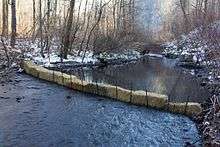Coal slurry
Coal slurry is a mixture of solids (mined coal) and liquids (usually water) produced by a coal preparation plant. As a slurry, coal is separated from non-combustable components (ash) and can be fractionated by particle size as well. Coal slurry can be transferred by pipeline[1] or with specialised pumps such as a progressive cavity pump to pump the highly abrasive, corrosive and viscous coal slurry.[2]
The scale of water usage and hence potential costs and problems is large. More than 7 billion tons of coal are mined per year (2010), using approximately 200 litres of water per ton.[3]
Environmental concerns

Ideally, coal slurry consists only of crushed coal and water, which can be separated perfectly at low cost. In practice, the separation is significantly costly(citation needed). Furthermore, the slurry consists also of very fine coal dust that results in a waste called blackwater, which is stored in large impoundment ponds, often together with coal ash. Such ponds are susceptible to disastrous releases, such as the Buffalo Creek flood of 1972. This impounded liquid waste can sometimes total billions of gallons in a single facility.
See also
References
- ↑ Red Valve Company: Coal Slurry Pipeline
- ↑ "Reasons why you should choose the right pump for coal slurry". 2012-07-18. Retrieved September 18, 2012.
- ↑ D. Woodruff and L. Macnamara, "Treatment of coal tailings" in "The Coal Handbook: Towards Cleaner Production" D Osborne, Ed. Woodhead Publishing, 2013. Print ISBN 0-85709-422-X. Web ISBN 978-0-85709-730-9
- ↑ Conlon, Kevin. "Officials: Coal slurry spill blackens 6 miles of West Virginia creek". CNN. Retrieved 2 May 2017.
External links
| Wikimedia Commons has media related to Coal slurry. |
